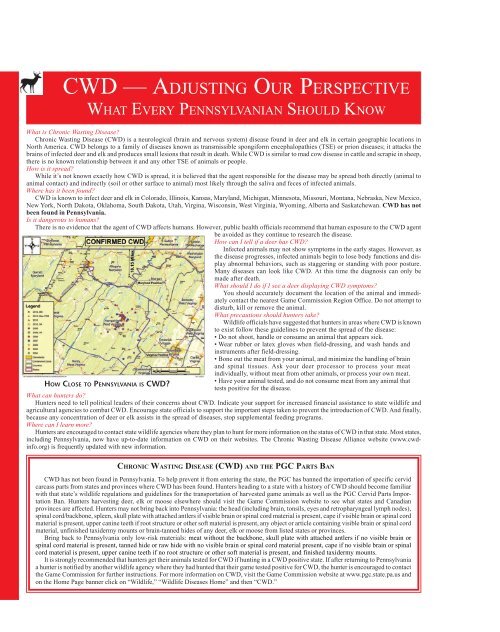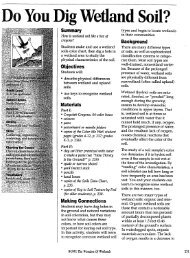Digest of Hunting and Trapping Regulation - Pennsylvania Envirothon
Digest of Hunting and Trapping Regulation - Pennsylvania Envirothon
Digest of Hunting and Trapping Regulation - Pennsylvania Envirothon
You also want an ePaper? Increase the reach of your titles
YUMPU automatically turns print PDFs into web optimized ePapers that Google loves.
CWD — ADJUSTING OUR PERSPECTIVE<br />
WHAT EVERY PENNSYLVANIAN SHOULD KNOW<br />
What is Chronic Wasting Disease?<br />
Chronic Wasting Disease (CWD) is a neurological (brain <strong>and</strong> nervous system) disease found in deer <strong>and</strong> elk in certain geographic locations in<br />
North America. CWD belongs to a family <strong>of</strong> diseases known as transmissible spongiform encephalopathies (TSE) or prion diseases; it attacks the<br />
brains <strong>of</strong> infected deer <strong>and</strong> elk <strong>and</strong> produces small lesions that result in death. While CWD is similar to mad cow disease in cattle <strong>and</strong> scrapie in sheep,<br />
there is no known relationship between it <strong>and</strong> any other TSE <strong>of</strong> animals or people.<br />
How is it spread?<br />
While it’s not known exactly how CWD is spread, it is believed that the agent responsible for the disease may be spread both directly (animal to<br />
animal contact) <strong>and</strong> indirectly (soil or other surface to animal) most likely through the saliva <strong>and</strong> feces <strong>of</strong> infected animals.<br />
Where has it been found?<br />
CWD is known to infect deer <strong>and</strong> elk in Colorado, Illinois, Kansas, Maryl<strong>and</strong>, Michigan, Minnesota, Missouri, Montana, Nebraska, New Mexico,<br />
New York, North Dakota, Oklahoma, South Dakota, Utah, Virgina, Wisconsin, West Virginia, Wyoming, Alberta <strong>and</strong> Saskatchewan. CWD has not<br />
been found in <strong>Pennsylvania</strong>.<br />
Is it dangerous to humans?<br />
There is no evidence that the agent <strong>of</strong> CWD affects humans. However, public health <strong>of</strong>ficials recommend that human exposure to the CWD agent<br />
be avoided as they continue to research the disease.<br />
How can I tell if a deer has CWD?<br />
Infected animals may not show symptoms in the early stages. However, as<br />
the disease progresses, infected animals begin to lose body functions <strong>and</strong> display<br />
abnormal behaviors, such as staggering or st<strong>and</strong>ing with poor posture.<br />
Many diseases can look like CWD. At this time the diagnosis can only be<br />
made after death.<br />
What should I do if I see a deer displaying CWD symptoms?<br />
You should accurately document the location <strong>of</strong> the animal <strong>and</strong> immediately<br />
contact the nearest Game Commission Region Office. Do not attempt to<br />
disturb, kill or remove the animal.<br />
What precautions should hunters take?<br />
Wildlife <strong>of</strong>ficials have suggested that hunters in areas where CWD is known<br />
to exist follow these guidelines to prevent the spread <strong>of</strong> the disease:<br />
• Do not shoot, h<strong>and</strong>le or consume an animal that appears sick.<br />
• Wear rubber or latex gloves when field-dressing, <strong>and</strong> wash h<strong>and</strong>s <strong>and</strong><br />
instruments after field-dressing.<br />
• Bone out the meat from your animal, <strong>and</strong> minimize the h<strong>and</strong>ling <strong>of</strong> brain<br />
<strong>and</strong> spinal tissues. Ask your deer processor to process your meat<br />
individually, without meat from other animals, or process your own meat.<br />
HOW CLOSE TO PENNSYLVANIA IS CWD?<br />
• Have your animal tested, <strong>and</strong> do not consume meat from any animal that<br />
tests positive for the disease.<br />
What can hunters do?<br />
Hunters need to tell political leaders <strong>of</strong> their concerns about CWD. Indicate your support for increased financial assistance to state wildlife <strong>and</strong><br />
agricultural agencies to combat CWD. Encourage state <strong>of</strong>ficials to support the important steps taken to prevent the introduction <strong>of</strong> CWD. And finally,<br />
because any concentration <strong>of</strong> deer or elk assists in the spread <strong>of</strong> diseases, stop supplemental feeding programs.<br />
Where can I learn more?<br />
Hunters are encouraged to contact state wildlife agencies where they plan to hunt for more information on the status <strong>of</strong> CWD in that state. Most states,<br />
including <strong>Pennsylvania</strong>, now have up-to-date information on CWD on their websites. The Chronic Wasting Disease Alliance website (www.cwdinfo.org)<br />
is frequently updated with new information.<br />
CHRONIC WASTING DISEASE (CWD) AND THE PGC PARTS BAN<br />
CWD has not been found in <strong>Pennsylvania</strong>. To help prevent it from entering the state, the PGC has banned the importation <strong>of</strong> specific cervid<br />
carcass parts from states <strong>and</strong> provinces where CWD has been found. Hunters heading to a state with a history <strong>of</strong> CWD should become familiar<br />
with that state’s wildlife regulations <strong>and</strong> guidelines for the transportation <strong>of</strong> harvested game animals as well as the PGC Cervid Parts Importation<br />
Ban. Hunters harvesting deer, elk or moose elsewhere should visit the Game Commission website to see what states <strong>and</strong> Canadian<br />
provinces are affected. Hunters may not bring back into <strong>Pennsylvania</strong>: the head (including brain, tonsils, eyes <strong>and</strong> retropharyngeal lymph nodes),<br />
spinal cord/backbone, spleen, skull plate with attached antlers if visible brain or spinal cord material is present, cape if visible brain or spinal cord<br />
material is present, upper canine teeth if root structure or other s<strong>of</strong>t material is present, any object or article containing visible brain or spinal cord<br />
material, unfinished taxidermy mounts or brain-tanned hides <strong>of</strong> any deer, elk or moose from listed states or provinces.<br />
Bring back to <strong>Pennsylvania</strong> only low-risk materials: meat without the backbone, skull plate with attached antlers if no visible brain or<br />
spinal cord material is present, tanned hide or raw hide with no visible brain or spinal cord material present, cape if no visible brain or spinal<br />
cord material is present, upper canine teeth if no root structure or other s<strong>of</strong>t material is present, <strong>and</strong> finished taxidermy mounts.<br />
It is strongly recommended that hunters get their animals tested for CWD if hunting in a CWD positive state. If after returning to <strong>Pennsylvania</strong><br />
a hunter is notified by another wildlife agency where they had hunted that their game tested positive for CWD, the hunter is encouraged to contact<br />
the Game Commission for further instructions. For more information on CWD, visit the Game Commission website at www.pgc.state.pa.us <strong>and</strong><br />
on the Home Page banner click on “Wildlife,” “Wildlife Diseases Home” <strong>and</strong> then “CWD.”



